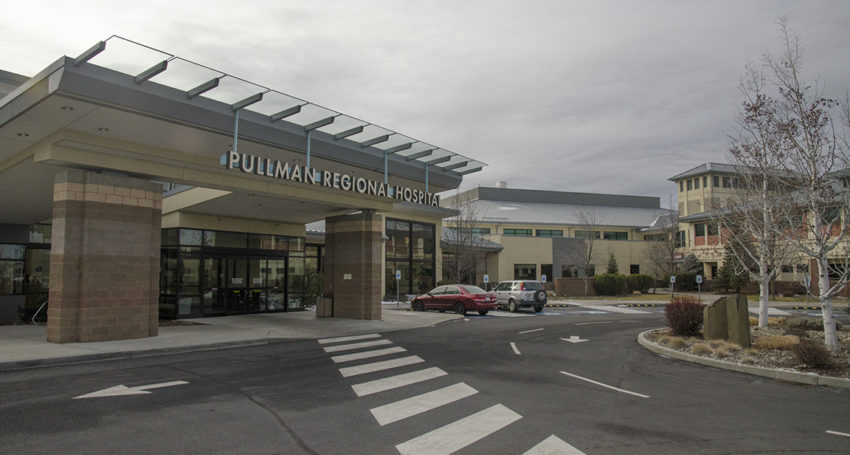Editor’s note, Oct. 24: The hospital’s proposed bond levy failed to pass April 23 due to insufficient voter turnout to certify the results. The hospital board decided to put the levy back on the Nov. 5 ballot. The plan is still the same though some timelines may have shifted back slightly. Check out our full Fall 2019 Voters Guide.
Pullman Regional Hospital has asked city voters to consider passing a $29 million bond later this month to help pay for an expansion and remodel, centralized care programs, technology investments and a different electronic records systems.
The parallel efforts, branded the “Next Era of Excellence,” total an estimated $40 million with design, construction and implementation over the next few years. Hospital CEO Scott Adams recently told Pullman officials the proposal would simplify local healthcare by providing “one-stop” services and new care centers.
“(The plan helps) connect the dots for people,” Adams said. “It’s integrated and comprehensive.”
Hospital officials also expect the county population to increase by about 2.5 percent over the next four years, primarily in residents of 65 years or older. They argue the region will likely see increased demand for locally accessible medical services.
A proposed Community Health Pavilion, which makes up half of the plan’s cost, would provide an additional 45,000 square feet for physician offices, a Center for Women’s & Children’s Health, care coordinators and a residency program. Though many specifics remain undecided pending the design phase of the project.
Adams said potential initiatives would expand preventative and specialized care.
“Right now healthcare is mostly episodic,” he said. “The business model doesn’t pay as much attention to teaching people how to stay well.”
Records show the hospital maintains 25 beds, employs 466 full- and part-time staff, and treats more than 12,000 Emergency Department visits each year. Data shows the hospital admits about 1,800 patients a year with half of those individuals reporting addresses inside the hospital taxing district.
The Proposition No. 1 bond levy would tax Pullman city residents at 99 cents per $1,000 of assessed property value starting next year. The levy would raise the taxes on the owner of a $250,000 home by approximately $167 next year, as it replaces a previous bond now phasing out in 2021.
Voters must return their ballots via mail or drop box by April 23. The levy requires 60 percent approval to pass. See below for additional background and details.
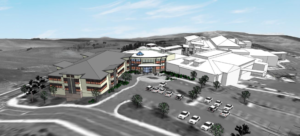
General plan overview and costs
Pullman Regional Hospital opened its doors about 13 years ago, replacing Pullman Memorial Hospital. It has undergone some remodels and an expansion since then, including the addition of a $3 million, 10,000 square foot same-day services building last year. The hospital has joint agreements with Gritman Medical Center and Whitman Hospital & Medical Center to operate both Palouse Surgeons and Palouse Specialty Physicians. Pullman Regional also owns a medical office building.
A local seven-person Board of Commissioners governs the hospital. Its most recent independent audit for 2017 reflects an annual operating budget of about $69 million.
The Next Era of Excellence includes four primary efforts: design and construction of the Community Health Pavilion ($20 million), transitioning to a different electronic medical records system ($10 million), remodeling current hospital space and services ($5 million), and purchasing new medical technology ($5 million).
In addition to the $29 million tax bond, the Pullman Regional Hospital Foundation and district reserve funds would contribute $11 million toward the effort. Read the 41-page Recommendation Report as well as the 12-page financial attachment prepared for the hospital board last fall.
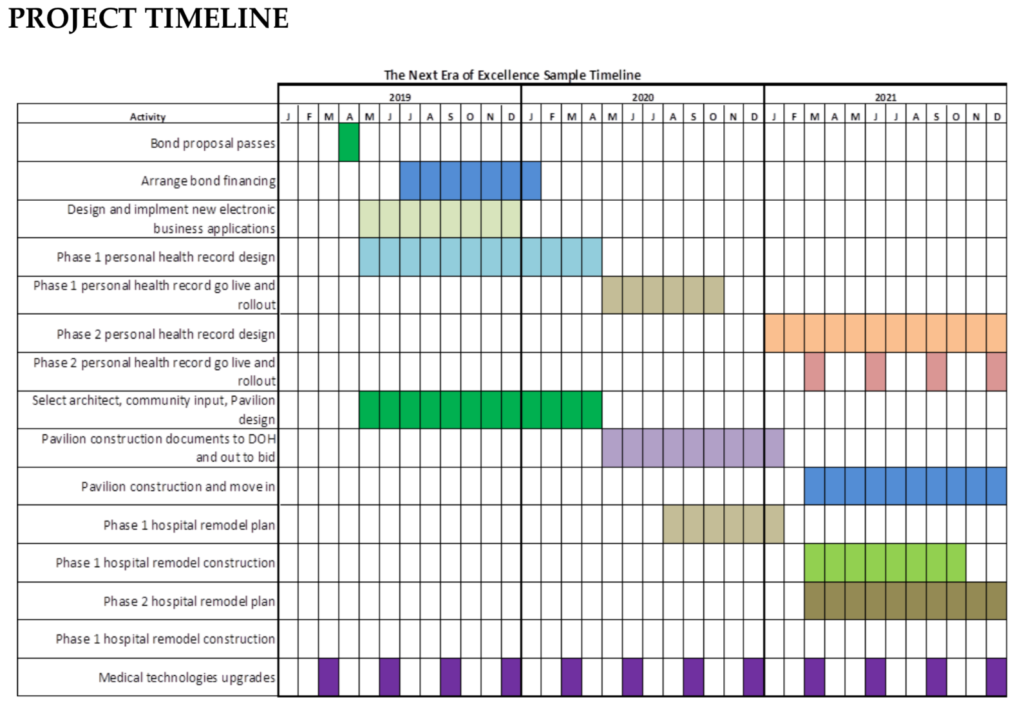
The Community Health Pavilion represents the largest and most visible aspect of the new proposal. The additional space would potentially house a Center for Women’s & Children’s Health as well as facilities to offer coordinated care and community wellness programs. Officials aspire to provide navigation services with consultants to help patients compare treatment or payment options.
“We don’t know if this is exactly how it would work when we get down to designing it,” Adams said of the proposal, “but it paints a picture of what’s possible.”
Local doctors would have more space for offices on the hospital campus. It could also accommodate a medical residency program, which would help train doctors locally and increase their likelihood of staying in the area.
A financial analysis noted the additional space would likely allow the hospital to either save money by reducing outside rental expenses or bring in new revenue by renting out internal space.
An electronic medical records system, officials say, would connect Pullman Regional with local doctors and other hospitals to help provide quicker and more consistent patient information. The plan would budget $10 million over seven years to transition to an Epic EMR program, which could share patient data via a universal portal.
Hospital spokeswoman Megan Guido also noted research indicated care providers found Epic easier to use with fewer clicks throughout the work process.
The hospital has used a Meditech electronic records system since at least 2014, reportedly paying about $800,000 a year for service. Officials say 56 percent of Washington hospitals now use Epic. They noted WSU students would be more likely to have shared Epic records with doctors or hospitals back home.
While many patients would appreciate not having to fill out redundant medical history questionnaires, news reports have noted problems with transferring critical orders or updates getting lost. MedStar Health launched a website in February to help track EMR usability issues or safety risks.
Remodeling existing hospital space would involve moving the laboratory to the same-day services building. It would also reorganize the internal layout to keep common outpatient services centralized while still allowing nearby access to physicians or specialized facilities.
Adams noted the campus would add some parking and reconfigure nearby spaces to prioritize patient accessibility. Doctors and staff would likely have to walk farther for parking options.
Investing in medical technology would provide additional funding for capital improvements or specialized equipment. The hospital reports it typically receives requests of $3 million to $4 million a year for updated equipment. The budget usually allows for closer to $1.5 million in spending.
“We’ve kind of held back on some of our technology upgrades,” Adams said. “You gradually get a little bit further behind.”
An outline of equipment request over the next five years includes $350,000 for new anesthesia machines, $1.5 million for a daVinci robotic surgery system, $2.6 million for a new MRI machine and other potential purchases.
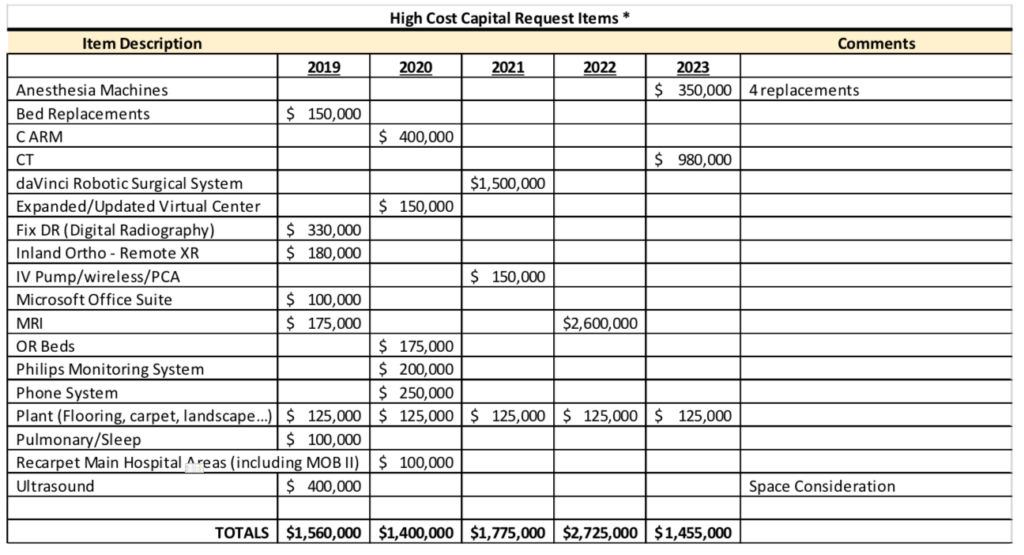
Hospital usage and taxing
A third-party projection of future healthcare needs estimated Pullman area service demands could increase by $20 million in the next five years. The 71-page report predicted about $12 million of that could go to Pullman Regional Hospital. It also estimated about 15 percent growth in healthcare related jobs.
The report also expected significant increases in residents 65 years or older by 2025 with reductions to all population groups between 15 and 64 years old. The aging population will likely need increased medical care.
Pullman Regional Hospital also conducted a survey last summer to assess community interests in healthcare services or concerns about the proposed expansion efforts. Survey results show about 440 people participated, 42 percent of whom were over the age of 60. Most reported having previously sought services at the hospital and receiving satisfactory care.
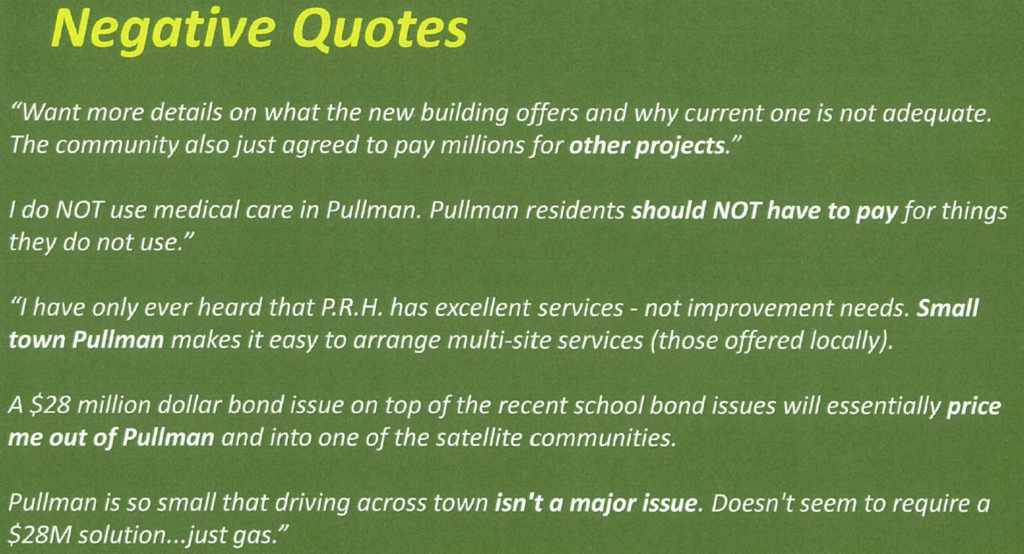
Those in favor of the Next Era proposal expressed a desire for high-quality health care and community. Those opposed cited tax fatigue and questioned the need for additional services or capacity at this time.
Hospital officials held a public comment hearing on the proposal in October. Nobody came to speak. Scott Vik with the Pullman Planning Commission submitted a letter expressing praise for the hospital, but questioning why Pullman city residents alone had to pay for the expansion of a regional medical facility. He also noted other local tax levies on the horizon.
“Why should my taxes go up to support the health care of those outside of Pullman?” he asked.
Department of Health patient data shows that Pullman Regional Hospital discharged 1,790 patients in fiscal year 2017, the most recent year available. Of those patients, 52 percent reported addresses within Pullman city limits. Another 15 percent reported addresses in Whitman County, but outside the city.
More than half of the 863 users from outside Pullman, reported an Idaho address.
“As a public district, non-profit hospital, our current district boundaries are Pullman city limits,” the hospital website states. “Changes to this would require a community wide effort to redistrict the voting area. Meanwhile, the Pullman Regional Hospital Foundation actively solicits private donations from residents outside the hospital district to support their community hospital.”
Whitman County also has three other hospital districts: one for Whitman Hospital & Medical Center in Colfax, one for an assisted living center in Garfield and one for the Tekoa Medical Clinic.
Pullman Regional Hospital currently has a general 32 cents per $1,000 of assessed property value maintenance and operations tax on city residents. The proposed 99 cents per $1,000 Next Era bond would replace a sunsetting 33 cent per $1,000 bond that phases out in 2021.
If the new bond is approved, officials would collect a total of $1.31 per $1,000 of assessed value next year for the hospital district to cover the ongoing general operations tax, the sunsetting bond and a portion of the new bond. A $250,000 homeowner would pay about $328 total.
Finally, here’s an FAQ from the hospital and transparency information.
Special election and other questions
Registered voters residing within Pullman city limits should start seeing ballots arriving today. Mail-in ballots require a stamp and must be postmarked by April 23. Ballots may be hand delivered to a local drop box at Pullman City Hall, outside the Compton Union Building at WSU or the County Elections Center in Colfax by 8 p.m. on Election Day.
The Garfield Cemetery District also has a $40,000 special tax levy on the April 23 ballot.
Here’s a recent look at what happens to your ballot after you send it.
Do you have other questions about the proposal? Submit them below:
